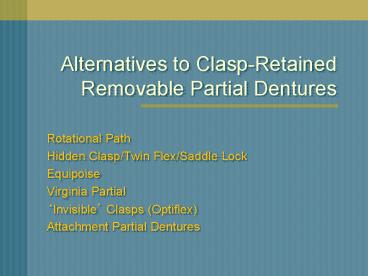Alternatives to Clasp-Retained Removable Partial Dentures PowerPoint PPT Presentation
1 / 52
Title: Alternatives to Clasp-Retained Removable Partial Dentures
1
Alternatives to Clasp-Retained Removable Partial
Dentures
- Rotational Path
- Hidden Clasp/Twin Flex/Saddle Lock
- Equipoise
- Virginia Partial
- Invisible Clasps (Optiflex)
- Attachment Partial Dentures
2
Fractured Abutments Kennedy Class IV (Category I)
3
Rotational Path RPD
- Elimination of clasps on one side of RPD
- Place rigid element into undercut
- Rotate other end into place (clasps)
4
Place in Undercut, Rotate Clasp into Place
5
(No Transcript)
6
Principles
- Large deep rests to provide support,
reciprocation - Reciprocation from adjacent teeth
- End that rotates must not have rigid elements in
undercut
7
Preparations
- Sufficient reduction if placing a crown
- Avoid undercuts in rests
- Prepare axis close to rotational axis
- Dovetail if no other element to keep abutment
from moving
8
Effective RPD DesignUnderutilized
9
Potential Problems
- Impossible to adjust
- Modification spaces (large blockout)
- Require sufficient undercut
- Require ability to hide metal guiding plate
- Requires good laboratory support
- Blockout
10
Hidden Clasp/Twin Flex
- Uses retentive undercut on proximal surface
- Requires sufficient undercut
- Space for clasp movement - hygiene
11
Hidden Clasp
- Designed by lab (retentoscope)
- If insufficient retention, labs tend to bring the
clasp around to facial - Variable retention (Soo et al, 1996)
12
Hidden Clasp Results
13
Equipoise
Lingual back-action clasp reciprocated Minimal
facial clasp display.
1mm
14
Equipoise
15
Equipoise
- Greater preparation
- Minimal Stress release
- Kennedy Class III situations
- Visible metal mesial embrasure display
16
Flexible Gasket RPDs
- Virginia Partial - elastomeric
- Cu-Sil - elastomeric
- Flexite/Valplast - thermoplastic
- No clasps
Cu-Sil
17
Flexible Gasket RPDs
- Difficult to adjust, polish
- Tend to tear, rough surface
Cu-Sil
18
Virginia Removable Partial Denture
- Silicone gasket around teeth
- Compensates for lost bone/gingival height
- Patients generally favour
19
Virginia Removable Partial Denture
- Hygiene
- Caries potential
- Liner lifespan
20
Virginia Removable Partial Denture
- Hygiene
- Caries potential
- Liner lifespan
21
Invisible Clasps (Optiflex)
- Non-metal, white
- OptiFlex Coating applied to metal clasps
22
Invisible Clasps (Optiflex)
- Thick, white, ugly clasp?
- Porous (plaque)
- Fatigue
- Bulky (comfort)
23
Other alternatives
- Bonding composite to clasp arm
- Anodizing clasp arm
- Precision Semi-Precision Removable Partial
Dentures
24
Overview of Prosthetic Attachments
25
Attachments
- Type of direct retainer
- Metal receptacle (matrix female) attached to
- An abutment or
- A prosthesis
- Closely fitting component (Patrix male) mates
with the receptacle
26
Uses for Attachments
- Fixed Partial Dentures
- Lack of draw between abutments
- Stress distribution
27
Uses for Attachments
- Removable partial dentures
- Comfort
- Less Bulk
- Within confines of Crown
28
Uses for Attachments
- Removable partial dentures
- Esthetics
- Retention
29
Uses for Attachments
- Overdentures
- Retention
30
Classifications of Attachments
- By type of Prosthesis
- Intracoronal / Extracoronal
- Precision / Semi-Precision
31
Intracoronal Attachments
- Female portion of attachment within a crown
32
Extracoronal Attachments
- Portion of attachment outside of crown/retainer
contours
33
Precision Attachments
- Box or key way
- One path of insertion
- Allows minimal to no rotation
34
Precision Attachments
- Milled prostheses
35
Semiprecision Attachments
- Less intimate fit
- Some leeway or resilience
- Principle to relieve stress
36
Overdenture Attachments
- Bars
- Balls
- Studs
- Magnets
37
(No Transcript)
38
Overdenture Attachments
39
Scope of Practice
- Generally beyond scope of GP
- GPs should be aware of possibilities
40
Advantages
- Esthetics
- Hygiene
41
Advantages
- Stress distribution
- deep rest
- directs stress along long axis
- Single path of movement
42
Advantages
- Comfort - fewer lingual components
43
Disadvantages
- Cost
- Maintenance
- Critical
- More complex types need more maintenance
- If poorly maintained
- Catastrophic failures
- Patient response
44
Disadvantages
- Extra tooth preparation for intracoronal
- If insufficient reduction
- over-contoured retainer
- Major reduction of non-restored teeth
45
Disadvantages
- Overdenture flange must draw with attachments
- Cant place flange in some undercuts
46
Disadvantages
- Technique sensitive
- Lab
- Parallelism
- Casting
- Processing acrylic
47
Disadvantages
- Technique sensitive
- Dentist
- Tissue base impression
- Relating Base to teeth
48
Contraindications
- Short clinical crowns
- Large pulps
- Dexterity problems
- Bruxers?
49
Design Considerations
- Precision Attachments
- Frictional retention
- Resilient or stress releasing
- Allows movement
- Lose stress distributing properties
50
Design Considerations
- Tissue Health
- Critical
- Compressible tissue - recovery
- Affects occlusion
51
Design Considerations
- Stress distribution
- Splinting advised by some to distribute stress -
probably not needed - Splinting complicates hygiene
- Tooth vs. tissue borne - some advise not on
distal extension (precision) - Cervical placement of forces
52
Design Considerations
- Metal - expensive, cast-to or solder
- Plastic forms - cheaper, casting errors
53
Patient Instructions
- Removed cleaned at least once/day
- Do not apply pressure - bending
- Nonabrasive denture toothpaste
- Soft tooth brush
- No bleach
54
Patient Instructions
- Leave precision attachment RPD in at all times
except for cleaning - Use vibrating motion when removing or replacing
the denture - Do not force
55
Patient Instructions
- Routine adjustments required
- Prevent major problems
- Dental checkups twice a year
- Advise type of attachments
- Record attachment type and replacement in chart
56
Summary - Attachment RPDs
- Attractive Advantages
- Maintenance critical and costly
- Long term success if
- Dentist uses utmost care
- Patient follows care maintenance regime
- If dentist or patient careless, ultimately fails
57
Summary - Esthetic Alternatives
- No panacea
- significant disadvantages with some designs
- Costs
- Managing expectations is important
- Initially
- Long-term

